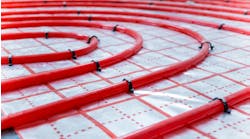Latest from Hydronics & Radiant
Sponsored
As winter approaches, the task of estimating the volume of fluid in a given hydronic system rears its head once again, and many questions about how to properly estimate or calculate the volume of fluid in a given system begin flying around. With many hydronic equipment manufacturers demanding water quality knowledge and treatment in order to provide proper equipment warranty, this timely article will help those people in the field understand their options.
The one thing that you don’t want to do is to take a wild guess. It will do one of two things, and neither have good endings. It will either cause you to overestimate the quantity of glycol necessary to properly bring fluid freeze protection into a reasonable range, or it will cause you to underestimate the needed glycol addition.
The consequences of overestimating are the waste of labor associated with pumping unneeded glycol into a system — to say nothing of the cost of the glycol itself — but more importantly, too much glycol is going to cost the consumer due to the fact that glycol and water together do not carry as much thermal energy as straight water does, resulting in system inefficiencies. Glycol also expands at a higher rate than straight water, which will cause a host of issues from leaking relief valves and potential dilution to torn expansion tank diaphragms, resulting in no thermal expansion absorption capacities and guaranteed dilution and loss of expensive glycols as a result.
Be aware that not all glycol is the same, even within the same category. First and foremost, it is always recommended that only corrosion-inhibited non-toxic glycols be used. Next, some glycols come premixed to a certain ratio. Make sure you are not adding water with the thought that you are working with 100 percent glycol to begin with. That, in and of itself, will cause you significant losses of hair, money and patience. Read the label and know with what it is you are dealing. Also, be absolutely certain that you are working with inhibited glycol, and that the existing water is not corrosive by nature. If the water is bad, and corrosive already, the corrosion inhibitors will immediately be consumed and no corrosion inhibition will remain. Thirty percent glycol by concentration is the typical minimum recommended solution of glycol in water to assure proper corrosion inhibition package is in place.
If the water is bad to begin with, it is recommended that the system be cleaned and flushed, and refilled using deionized water or equal quality fill water.
The consequence of not putting in enough glycol, as mentioned above, is that you will end up with a weak, if existent at all, corrosion inhibition package. When glycol becomes acidic, it accelerates its own corrosivity and the production of corrosion byproducts. If you have glycol in a system you must check it annually for freeze protection as well as corrosion inhibitor and pH levels. That, and not being able to maintain a reasonable freeze resistance value, are guaranteed road maps to a disaster due to weak glycol packages.
Also, make certain that the glycol you are using is compatible with all of the metals within the system. Aluminum requires special attention, as does non-oxygen barrier tubing,
I will now talk about the measurement aspect. In many cases, you will be dealing with an existing system of which you have zero knowledge other than what you can see within the mechanical room. Guessing at the volume rarely works out to anyone’s advantage. Let the consumer know that it is going to cost a little extra money up front to determine the quantity of water volume within the system in order to properly address the situation.
As previously noted, test the existing water, not only within the system, but also at the source. If the system is soured, recommend cleaning and flushing using good-quality cleaning and flushing chemicals from a company that specializes in that specific area.
We have a free Glycol Volume Estimator at the RPA website under the “Members Only” section.
If the source water is out of sorts (high ppm of chlorides, high TDS, etc.) consider purchasing either bulk deionized water for mixing and filling, or purchasing/renting a portable deionization unit to generate the perfect water for filling and mixing.
Although there are some titrate methods out there, I have found that the most reliable way, if correctly performed, is to blow the system fluids out using compressed air and record the exiting volume of recovered fluid being removed in buckets or barrels. You don’t need to save it, but accuracy is fairly important. Once you have determined how much fluid the system holds, you are able to calculate the exact quantity of fluid necessary to cleanse and refill the system.
Another method is to calculate the linear footage of given pipe sizes within the system. This is much trickier in a finished building because you can’t see the mains, and where they transition from larger to smaller, and vice versa. If you built the system (radiant floors, for example) this task is much easier, because most of the guesswork is eliminated.
We have a free Glycol Volume Estimator at the RPA website under the “Members Only” section. You have to know the quantity of various pipe sizes contained within the system as well as heat source volume. This is yet another good reason to join this organization. Feel free to download it and use it to determine system fluid volumes, but remember: If you put garbage in, you’ll get garbage out (GIGO).
Tune in next month, when I will tell you why it is not a good idea to have a continuous makeup on a closed loop heating system, especially one with antifreeze in it. Until then, from all of us here at IAPMO/RPA to all of you and yours, have a happy Thanksgiving. Be thankful for what you have. We are thankful for your support.
Mark Eatherton material on this website is protected by Copyright 2016. Any reuse of this material (print or electronic) must first have the expressed written permission of Mark Eatherton and CONTRACTOR Magazine. Please contact via email at: [email protected].
Mark Eatherton
Mark Eatherton material on this website is protected by Copyright 2017. Any reuse of this material (print or electronic) must first have the expressed written permission of Mark Eatherton and CONTRACTOR Magazine.


